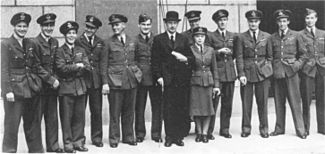Sir Max Aitken, 2nd Baronet facts for kids
Quick facts for kids
Sir Max Aitken, 2nd Baronet
|
|
|---|---|

Wing Commander Aitken, fourth from left, with other members of "The Few", September 1942.
|
|
| Birth name | John William Maxwell Aitken |
| Born | 15 February 1910 Montreal, Quebec, Canada |
| Died | 30 April 1985 (aged 75) |
| Allegiance | United Kingdom |
| Service/ |
Royal Air Force |
| Years of service | 1935–1952 |
| Rank | Group Captain |
| Commands held | Banff Strike Wing (1944–45) No. 68 Squadron RAF (1941–43) No. 601 Squadron RAF (1940) |
| Battles/wars | Second World War |
| Awards | Distinguished Service Order Distinguished Flying Cross Mentioned in Despatches War Cross (Czechoslovakia) |
| Relations | Max Aitken, 1st Baron Beaverbrook (father) Maxwell Aitken, 3rd Baron Beaverbrook (son) Janet Gladys Aitken (sister) |
| Other work | Chairman of Beaverbrook Newspapers Ltd. Politician |
Sir John William Maxwell Aitken, born on February 15, 1910, was a brave fighter pilot during the Second World War. He was known as a "flying ace" because he shot down many enemy planes. He also became a politician and later led a big newspaper company. His father was Lord Beaverbrook, a very famous person in the newspaper world.
Contents
Early Life and Education
Maxwell Aitken was born in Montreal, Canada. His parents were Gladys Henderson Drury and Max Aitken. He had a sister named Janet Gladys Aitken.
He went to several schools, including Sandroyd School and Westminster School. He also studied at Pembroke College, Cambridge. Maxwell was a great sportsman. He played football for his university and was a very good golfer. He loved flying and spent time flying across Europe and the USA in the 1930s. In 1935, he joined the Royal Auxiliary Air Force, which was a part-time air force.
A Brave Pilot in World War II
Maxwell Aitken became a flight lieutenant in May 1940. He flew planes like the Bristol Blenheim and the Hawker Hurricane with No. 601 Squadron RAF during the early part of the Second World War. He became the leader of his squadron in June 1940.
He earned two important awards for his bravery: the Distinguished Flying Cross in 1940 and the Distinguished Service Order in 1942. He was recognized for shooting down eight enemy aircraft.
After leaving his squadron, he led No. 68 Squadron RAF, a unit that fought enemy planes at night. He shot down four more planes during night missions. Later, he served in the Middle East and shot down two more planes while flying a Bristol Beaufighter.
In 1944, he became a wing leader for the Banff Strike Wing. He reached the high rank of group captain. Overall, he was credited with shooting down 16 and a half enemy planes. He was even mentioned in a famous book about the war called The Last Enemy.
Life After the War
After the war, in 1946, Maxwell Aitken joined his family's newspaper business. He became a director and later the Chairman of Beaverbrook Newspapers Ltd. This company owned several big newspapers.
In 1945, he was elected as a Member of Parliament (MP) for Holborn. An MP is a person who represents a local area in the country's government. He helped make laws and decisions for the country. He also served as the Chancellor of the University of New Brunswick in Canada.
You can see him in the famous World War II TV show The World at War, where he shares his experiences.
Starting Powerboat Races
In the late 1950s, Maxwell Aitken watched an exciting powerboat race in Miami. This inspired him to start a similar race in England. In 1961, he announced the creation of the Cowes Torquay Offshore Powerboat Race.
He worked with John Coote to create the rules for this new race. Their goal was to help improve fast boats and make boating safer. The Cowes Torquay race celebrated its 50th year in 2010, thanks to Aitken's idea.
London International Boat Show
Maxwell Aitken also helped start the London International Boat Show in 1954. His newspaper, the Daily Express, helped sponsor the event. This show became a big event for boat lovers.
His Family Life
Maxwell Aitken was married three times:
- His first wife was Cynthia Monteith (1939–1944).
- His second wife was Jane Kenyon-Slaney (1946–1950). They had two daughters, Kirsty and Lynda. His daughter Kirsty is a close friend of Queen Camilla.
- His third wife was Violet de Trafford (1951–1985). They had a son, Maxwell, and a daughter, Laura.
When his father, the 1st Baron Beaverbrook, passed away in 1964, Maxwell Aitken inherited the title of Baron Beaverbrook. However, he decided to give up the title just three days later. He said he wanted his father to be the only Lord Beaverbrook in his lifetime. When Maxwell Aitken died in 1985, his son, also named Max Aitken, took on the title.

